The Cosmic Dance: A Gravity Test of Epic Proportions
Share- Nishadil
- November 26, 2025
- 0 Comments
- 4 minutes read
- 9 Views

Two Doomed Stars Are Pushing Einstein's Gravity to Its Absolute Limit
Deep in space, a pair of neutron stars, both pulsars, are locked in a deadly cosmic ballet, spiraling ever closer. This incredible system offers scientists an unprecedented chance to scrutinize Einstein's theory of general relativity, watching gravity's extreme effects play out in real-time.
Imagine, if you will, a cosmic waltz, but one with the highest stakes imaginable. Out in the vast, inky blackness of space, two incredibly dense, incredibly precise celestial bodies are locked in just such a dance – a deadly, spiraling embrace that’s pushing the very fabric of our understanding of the universe to its absolute limit. We’re talking about a unique binary system, where two neutron stars, both acting as pulsars, are slowly but surely spiraling inward, destined to collide in a spectacular cosmic crescendo.
This isn't just any old astronomical observation; oh no, this is science at its most thrilling. This particular duo, known to astronomers as J0737-3039, offers an almost unbelievably perfect laboratory for testing none other than Albert Einstein’s general theory of relativity. You see, Einstein’s groundbreaking theory, which redefined our understanding of gravity, predicts that massive, accelerating objects should emit "gravitational waves" – ripples in spacetime itself. And here’s the kicker: the emission of these waves should, over vast stretches of time, cause the objects to lose energy, leading them to spiral closer and closer together.
Now, while this binary pulsar system has been a superstar in validating general relativity for years, every new observation, every tiny tick of its cosmic clock, brings fresh insights. It’s like getting a new, sharper lens for an already incredible telescope. Scientists are tracking the orbital decay of these neutron stars with astonishing precision. We're talking about measuring changes that are absolutely minute, yet profoundly significant. The incredible regularity of their pulses – think of them as cosmic lighthouses – allows for this exquisite accuracy, letting researchers pinpoint their positions and measure their decreasing orbital period with breathtaking exactness.
So, what's the big deal, you might ask? Well, this isn't just about confirming what we already suspect. It’s about pushing the boundaries, making sure Einstein’s theory holds up under the most extreme conditions the universe can throw at it. While general relativity has passed every test with flying colors so far, there are always alternative theories of gravity lurking in the scientific shadows. These "challenger" theories often predict slightly different rates for this orbital decay. By observing J0737-3039 with such meticulous care, scientists can effectively rule out or constrain these alternative ideas, strengthening our confidence in general relativity or, perhaps, revealing tiny cracks that could point to new physics.
It's truly mind-boggling to think about. These two stellar remnants, the cores of massive stars that once exploded as supernovae, are locked in an orbit so tight that they complete a revolution in just 2.4 hours! And they're not just any neutron stars; they're both pulsars, meaning they're spinning incredibly fast and emitting beams of radio waves that sweep across Earth like a cosmic lighthouse. One of them spins at a dizzying 44 times per second! It's this double-pulsar nature that makes the system so invaluable for precision measurements.
The cosmic countdown is already underway. Current calculations suggest these incredible objects are on a collision course, set to merge into a single, even more massive neutron star – or perhaps even a black hole – in about 85 million years. That might sound like an eternity to us, but in cosmic terms, it’s just a blink. When they finally do merge, it will unleash a phenomenal burst of gravitational waves and electromagnetic radiation, an event that future generations of instruments will undoubtedly be poised to observe.
In the grand scheme of things, this ongoing observation of J0737-3039 isn't just about two stars. It’s about our understanding of gravity itself, the fundamental force that shapes the universe. It’s about peering into the extreme realms of physics, where spacetime warps and stretches, and where the most profound theories are put to the ultimate test. It reminds us that even in the most distant corners of the cosmos, the universe continues to reveal its secrets, one precise measurement at a time, always inviting us to look deeper, to question, and to marvel.
Disclaimer: This article was generated in part using artificial intelligence and may contain errors or omissions. The content is provided for informational purposes only and does not constitute professional advice. We makes no representations or warranties regarding its accuracy, completeness, or reliability. Readers are advised to verify the information independently before relying on







